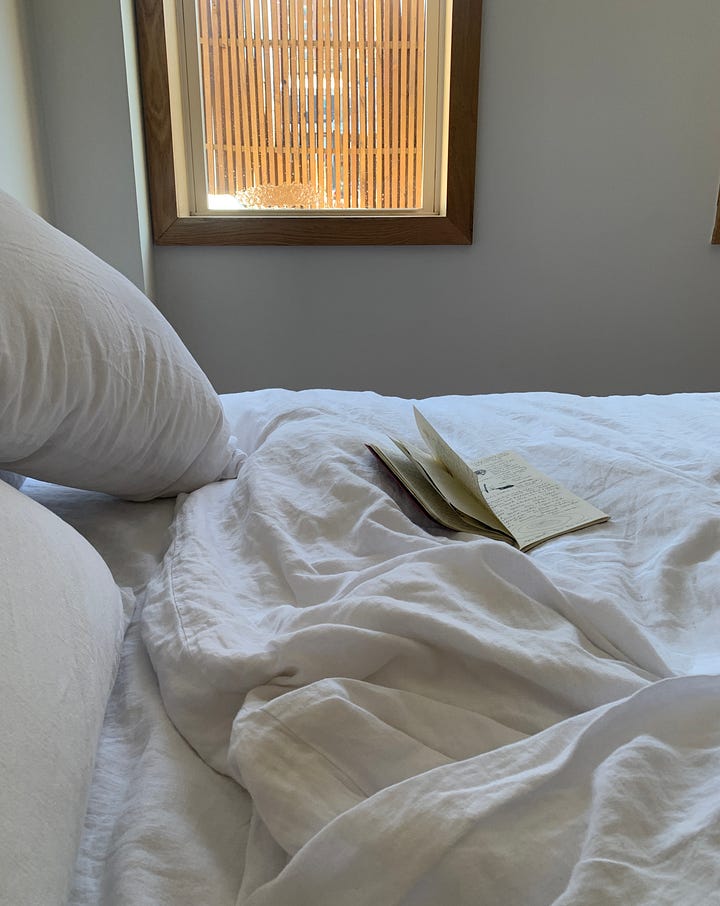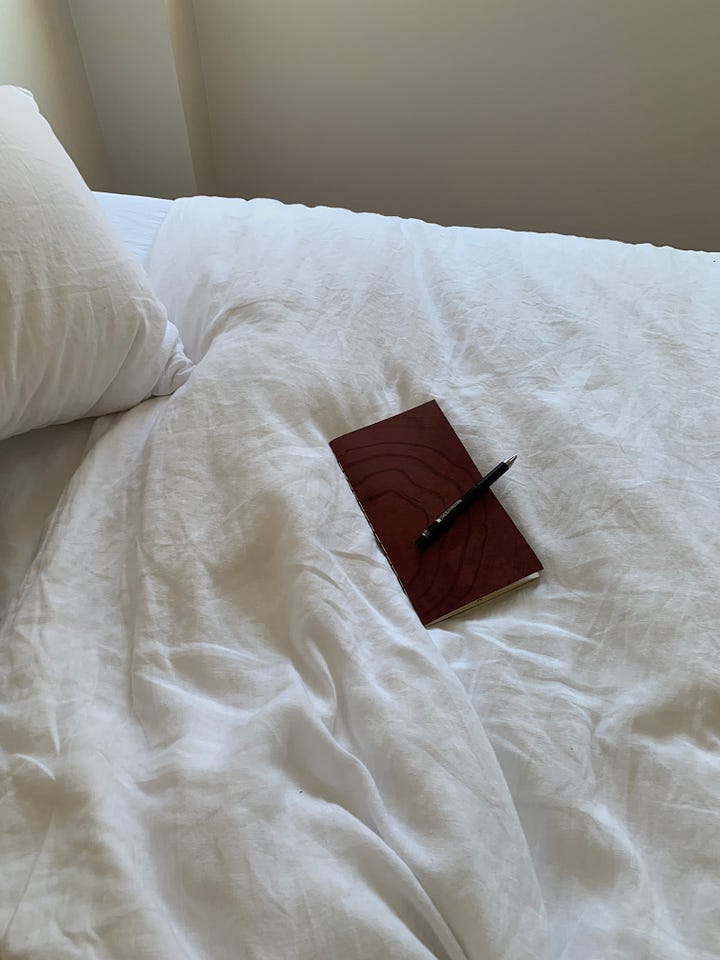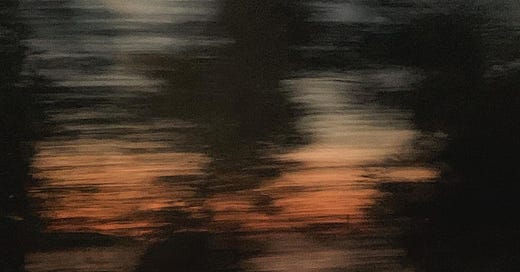It’s after midnight and below freezing when I head back on the subway. The train ride is long; an hour, local, from the city to Brooklyn, and it’s moving slowly, rocking gently this time, thankfully, not dislodging our steps as we stand as the stops slip past. It will be an hour and a half into the new day — 1:30 in the morning — by the time I lay into the soft structure of the bed at home.
In a train car, and then the subway, I am dialoguing internally: mind telling body about the cold walk from the train to the apartment in anticipation of what’s still up ahead, while reminding of and coaxing into the soon needed sleep, conversing, as one does, while traveling alone, mediating between inner experience, desire, need, and the world outside.
Despite this interiority, there is a sense of connection here on the subway train. Those of us who have entered this midnight vortex, while separate, seem to share similar experiences. We yawn and check the lights on the map, gently scroll mindlessly on phones, only on occasion are we speaking.
We are rocked together but not too close inside these metallic mazes. There is a language and a landscape to these transports: besides averting your eyes, there is generally a preference for silence, save for the occasions in which the conductors speak on the overhead, the automated messages play. Gazes down, these subterranean meanderings feel like their own zen practice — complete with their own rules, suggestions, guides. We practice the art of focused-yet-unfocused gazes; the play between personal and collective space apparent and sensed, but ideally not overlapping, ideally no boundaries breached; a place of movement in these fast and slow-moving metal cars, our backs leaned against supports of doorways and shining plastic seats, these holding places where we share temporary time and body heat together. The places our eyes do not meet.
In this midnight, this faint start to the early hours of Monday, the penumbral edge of the rush of the week, a lull comes, from the sound and speed and shake of the train. I am hummed into an alert wakefulness riding into these earliest moments of the day. The landscape shifts: the group of us shifting into and out of the center of the car as the stops pass by.
For most of the ride, I stand in the middle, shoulders heavy with bags from traveling, suitcase at my feet, aware of space in close and widening circles, until the doors open, until the mechanized voices of the announcements shift, the shape of the crowd inside the subway changes, and I am nestled standing in the corner by the door. Finally. I am alert but tired, stable and shifting, grateful for the armature the guardrails provide: just enough stability and support to lean to one side, to rest gently, a little deeper, as this train goes on. We are throttling faster now through the ventricles of this city, onward, underground, passed into the day, endeavoring to stay alert and gentle throughout the journey.
Entering my inner world, I tune in and feel my own structured form — sensing bones in tandem with muscles and skin, viscera, the physicality that reminds me of my own present tense. I lean into the senses. I lean into cold metal bars, sensing the structure that allows me to settle and soften. Think of other structures: predictable rhythms, a sturdy table, a steady friendship, a general routine — each a space to rest into and turn toward, lean into, until the inevitability of pushing ones self out into the world, arrives, wakefulness comes, and we must awaken again. I remembered the sensation just before arriving into the doorway of the train with pulsing hamstrings, shoulder dragging a heavy suitcase, skin slightly heavy with cold to the bone, wind, and the near tipping point of sweating, heart rate wild.
Last week, I found myself in the grips at the root of the word essay (“to try, attempt, test, endeavor”). It’s midweek and I am caffeinated, moving fast, trying to locate myself in a larger landscape of writing, orienting to the ground of this field of expressing when I learn this, this fragment of practice, this definition I’d read somewhere before but remembered again. In that moment, it felt like a fire had formed. A week later lamplights will fly by above ground on train tracks and in these subterranean subways, colors bleed golden glows and trails of blue and midnight in my periphery as I am flying in the train car hugged along the highway toward the city I love and urge to return to, an attempt at returning. The rush reminding me of the same/similar feeling of discovering that the root of essay.
An essay is “an attempt, a trial,” Ellen Bass writes. I read this and feel it pass from mind, cognition, into heart, lungs, body, breathing in, filling up, as the response, the deep yes flows past layers of sturdy muscle, fascia, into cell, into armature, into bone. The word is functioning as a space to channel feeling — that is, it’s a connection, curiosity, inspiration, traveling throughout my own channels like traveling by train. It is the seed to spark the feeling of elation, the body after a run, a long varied talk with a loved one, the lungs after pumping fast and faster, reaching past boredom into levels of bliss and elation, then coming back down to earth again. (Later, in the calm warmth of a morning home, I will revisit essays and more from Bass, who writes about words and their functional nature. “To carry food,” she says, “keep warm, pass on the muscle of those who stood and those who fell. Words to be a place to come home to.”)
I mulled around this process, this attempting, this essay, arriving again to my momentary home. The edges of this essay arrived on a street corner, early in the morning, suitcase pulled behind me, first hints and themes and words dictated softly into the perimeter of my phone. To attempt as in not to be perfect. To try as in acts of returning, leaning in, standing up again, repetition. To write, to notice, to be: it’s an endeavor, not at end goal. A process. A firm yet moving place to lean into. A steadily moving practice. A place where we keep going.
As creatives, and as humans, no matter what form our expression takes, the details we turn toward build up and amass a kind of solid, yet moving picture. Our writing is the core, the frame, the structure we lean into. What we lean into shows us what matters most. In Writing Down the Bones: Freeing the Writer Within, Natalie Goldberg writes,
“We are important and our lives are important, magnificent really, and their details are worthy to be recorded. This is how writers must think, this is how we must sit down with pen in hand. We were here; we are human beings; this is how we lived. Let it be known, the earth passed before us. Our details are important”.
Lately, I have been considering stability and structure and how that crafts the space for flow to form. I sense into and out of thoughts, ideas, and sensations. Through writing and being I interrogate my own physicality, interiority, identities inside of self and communities, many of us existing inside of cities, on train lines, along highways. This process shows life’s inherent fluctuations, life and body both breathing. How our bodies, these physical forms we carry from place to place, bring with them inherent stories, new details, slight shifts, sensations, the histories before us, and the stories we watch, create, and unfold.
Writing takes the seen, unseen, the witnessed, imagined and makes it material; we write about what matters, and in that writing create meaning. Filling up with life and then pouring out is the practice of writing, or creating, like filling up the subway car and exhaling onto the cold winter streets. Take a breath in, catch the train, feel the inside of your physical form, notice the moment of connection between your breath and your physical body in the space, and how you exhale into the world outside and how this is not dissimilar from navigating the subway home on a winter night after midnight.
To write an essay, or to write at all, is matter of trying, of process, continuing. Of taking forms to play around within and moving them, shifting them. Playing with shape. Sensation. Inherent in that process of trying is falling down, or failing, a counterweight to perfectionism — a way of learning how to lean in one way, then the other, attempts at landing in some centered, grounded place again and again, even if only temporarily, to find those places where we can rest, to find the places that careen us into unknown nights into the yeses residing deeply, resoundingly within our bodies. As Goldberg goes on to say, again, in Writing Down the Bones,
“Our task is to say a holy yes to the real things of our life as they exist… We must become writers who accept things as they are, come to love the details, and step forward with a yes on our lips so there can be no more noes in the world, noes that invalidate life and stop these details from continuing.”
This essay is a way of trying, then — of inviting in intricacy. Of encouraging a story, an image, a shape, no matter the form, to make its way onto your page. Start with what you sense, if you’re stuck, start with what you notice, feeling into your experience. Write the stories of the now, this moment, your inner world, the world as it is, inside and outside: your histories, stories overlapping in shared spaces, stories on glowing screens.
Write the taste on your tongue, the yes in your mind, the no in your body. Write, draw, cook, paint, reflect what rushes into the vessels of your heart, what oxygenates, what makes your mind whirr, your breath rush faster, and what helps you settle back down.
Try one minute, five minutes, a whole page. A month, a year. Draw in one color, a single word that moves you, write about the stories you contain or the shapes your body makes, or what you’re sharing. Try for one month, or one day. Notice what breathes into you, what moves you, what moves through you. Write to what grips you, draw what nourishes you, again, and again.
Let this trying — this creative process — travel with you, traversing time, space, and landscape: Examine your own surfaces, your familiarly traveled pathways, your unfamiliar terrains, your depths, as you try to navigate your subterranean places. Keep trying.
Let’s write what we’re seeing, feeling, sensing, what we are attempting to form and reform, what we are crafting, imagining, shaping, holding, tending to, and making. Let’s write and draw and hold our hands and hold these experiences of life, leaning into the winding subways of our bodies, stories, and minds, and that which is breathing in, and breathing out, and breathing in between. Cities, and midnights. Let’s try, and try again.
nourished by, nourishing:
Reading | best american essays, 2019 edited by rebecca solnit, specifically gripped and moved by “obituary for dead languages” by heather altfeld, here, for the ways i did not know i held grief about loss of language, but then read and discovered i did. this interview with ellen bass, on tenderness, being with the unbearable, and poems.
Making | shapes with ink. videos. map journal revival and rethinking. soup of broth, northern beans, black pepper, fresh dill, lemon, topped with yogurt on repeat.
Enjoying | teaching; snow jogs; late night plates of french fries, shared; traveling.


upcoming experiences:
1/24 Taste + Write: Meditating on the Senses
1/31 Bookbinding: Pamphlet Stitch
2/4 Greenpointer’s Market
2/7 Suminagashi Cards
2/13 Online: Letter Writing
2/13 Online: Journaling for Love





